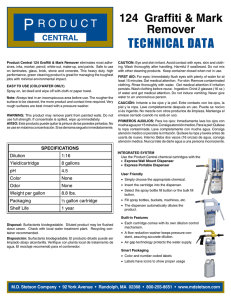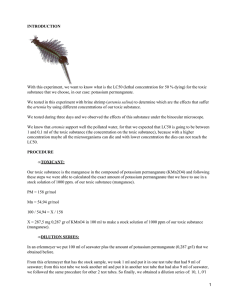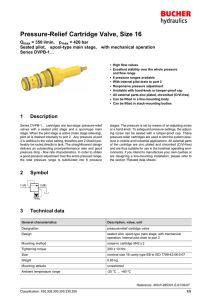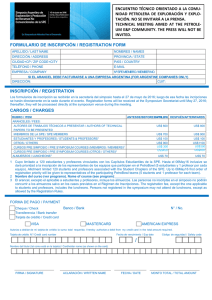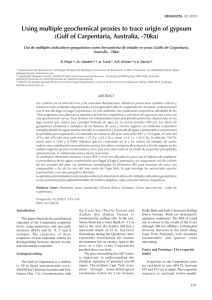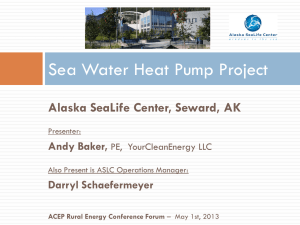Trace Level Determination of Domoic Acid in Seawater by Off
Anuncio
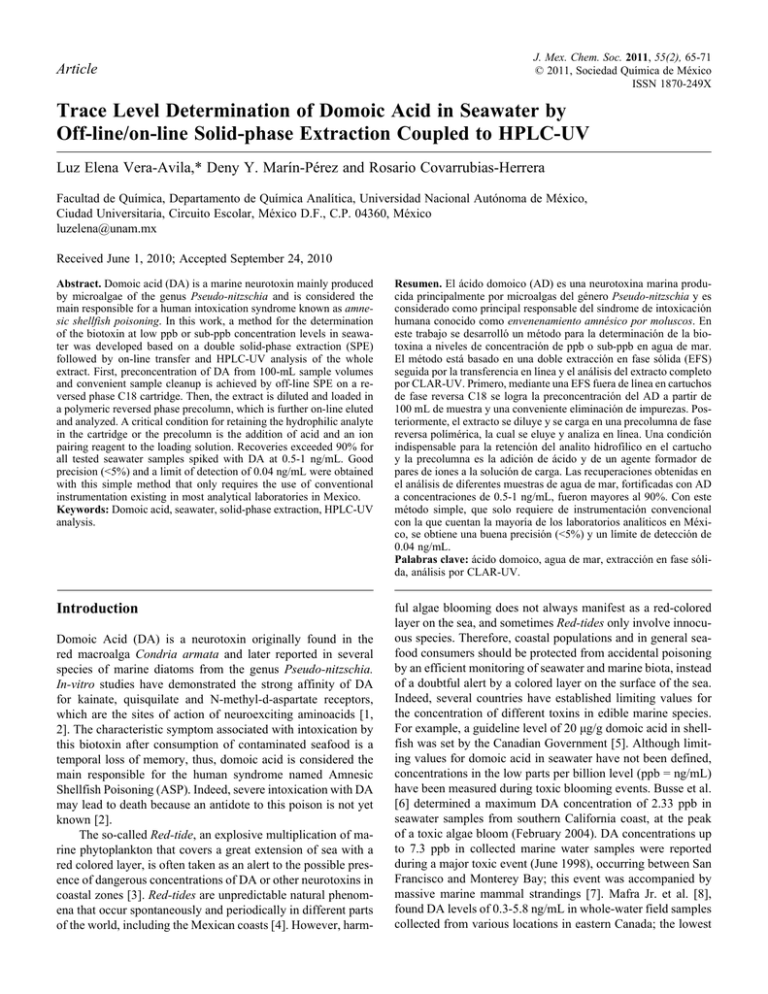
J. Mex. Chem. Soc. 2011, 55(2), 65-71 Trace Level Determination of Domoic Acid in Seawater by Off-line/on-line Solid-phase Extraction Coupled to HPLC-UV 65 Article © 2011, Sociedad Química de México ISSN 1870-249X Trace Level Determination of Domoic Acid in Seawater by Off-line/on-line Solid-phase Extraction Coupled to HPLC-UV Luz Elena Vera-Avila,* Deny Y. Marín-Pérez and Rosario Covarrubias-Herrera Facultad de Química, Departamento de Química Analítica, Universidad Nacional Autónoma de México, Ciudad Universitaria, Circuito Escolar, México D.F., C.P. 04360, México [email protected] Received June 1, 2010; Accepted September 24, 2010 Abstract. Domoic acid (DA) is a marine neurotoxin mainly produced by microalgae of the genus Pseudo-nitzschia and is considered the main responsible for a human intoxication syndrome known as amnesic shellfish poisoning. In this work, a method for the determination of the biotoxin at low ppb or sub-ppb concentration levels in seawater was developed based on a double solid-phase extraction (SPE) followed by on-line transfer and HPLC-UV analysis of the whole extract. First, preconcentration of DA from 100-mL sample volumes and convenient sample cleanup is achieved by off-line SPE on a reversed phase C18 cartridge. Then, the extract is diluted and loaded in a polymeric reversed phase precolumn, which is further on-line eluted and analyzed. A critical condition for retaining the hydrophilic analyte in the cartridge or the precolumn is the addition of acid and an ion pairing reagent to the loading solution. Recoveries exceeded 90% for all tested seawater samples spiked with DA at 0.5-1 ng/mL. Good precision (<5%) and a limit of detection of 0.04 ng/mL were obtained with this simple method that only requires the use of conventional instrumentation existing in most analytical laboratories in Mexico. Keywords: Domoic acid, seawater, solid-phase extraction, HPLC-UV analysis. Resumen. El ácido domoico (AD) es una neurotoxina marina producida principalmente por microalgas del género Pseudo-nitzschia y es considerado como principal responsable del síndrome de intoxicación humana conocido como envenenamiento amnésico por moluscos. En este trabajo se desarrolló un método para la determinación de la biotoxina a niveles de concentración de ppb o sub-ppb en agua de mar. El método está basado en una doble extracción en fase sólida (EFS) seguida por la transferencia en línea y el análisis del extracto completo por CLAR-UV. Primero, mediante una EFS fuera de línea en cartuchos de fase reversa C18 se logra la preconcentración del AD a partir de 100 mL de muestra y una conveniente eliminación de impurezas. Posteriormente, el extracto se diluye y se carga en una precolumna de fase reversa polímérica, la cual se eluye y analiza en línea. Una condición indispensable para la retención del analito hidrofílico en el cartucho y la precolumna es la adición de ácido y de un agente formador de pares de iones a la solución de carga. Las recuperaciones obtenidas en el análisis de diferentes muestras de agua de mar, fortificadas con AD a concentraciones de 0.5-1 ng/mL, fueron mayores al 90%. Con este método simple, que solo requiere de instrumentación convencional con la que cuentan la mayoría de los laboratorios analíticos en México, se obtiene una buena precisión (<5%) y un límite de detección de 0.04 ng/mL. Palabras clave: ácido domoico, agua de mar, extracción en fase sólida, análisis por CLAR-UV. Introduction ful algae blooming does not always manifest as a red-colored layer on the sea, and sometimes Red-tides only involve innocuous species. Therefore, coastal populations and in general seafood consumers should be protected from accidental poisoning by an efficient monitoring of seawater and marine biota, instead of a doubtful alert by a colored layer on the surface of the sea. Indeed, several countries have established limiting values for the concentration of different toxins in edible marine species. For example, a guideline level of 20 μg/g domoic acid in shellfish was set by the Canadian Government [5]. Although limiting values for domoic acid in seawater have not been defined, concentrations in the low parts per billion level (ppb = ng/mL) have been measured during toxic blooming events. Busse et al. [6] determined a maximum DA concentration of 2.33 ppb in seawater samples from southern California coast, at the peak of a toxic algae bloom (February 2004). DA concentrations up to 7.3 ppb in collected marine water samples were reported during a major toxic event (June 1998), occurring between San Francisco and Monterey Bay; this event was accompanied by massive marine mammal strandings [7]. Mafra Jr. et al. [8], found DA levels of 0.3-5.8 ng/mL in whole-water field samples collected from various locations in eastern Canada; the lowest Domoic Acid (DA) is a neurotoxin originally found in the red macroalga Condria armata and later reported in several species of marine diatoms from the genus Pseudo-nitzschia. In-vitro studies have demonstrated the strong affinity of DA for kainate, quisquilate and N-methyl-d-aspartate receptors, which are the sites of action of neuroexciting aminoacids [1, 2]. The characteristic symptom associated with intoxication by this biotoxin after consumption of contaminated seafood is a temporal loss of memory, thus, domoic acid is considered the main responsible for the human syndrome named Amnesic Shellfish Poisoning (ASP). Indeed, severe intoxication with DA may lead to death because an antidote to this poison is not yet known [2]. The so-called Red-tide, an explosive multiplication of marine phytoplankton that covers a great extension of sea with a red colored layer, is often taken as an alert to the possible presence of dangerous concentrations of DA or other neurotoxins in coastal zones [3]. Red-tides are unpredictable natural phenomena that occur spontaneously and periodically in different parts of the world, including the Mexican coasts [4]. However, harm- 66 J. Mex. Chem. Soc. 2011, 55(2) value corresponds to a sample where Pseudo-nitzschia cells were not even detected by microscopy. Because of the extremely low concentration of biotoxins expected in seawater during harmful algae blooming events, analytical determinations have been preferably conducted in bivalve molluscs that accumulate these poisons by direct filtration of the plankton cells. Thus, several analytical methods for determining domoic acid in phytoplankton, mussels and in general all kind of shellfish have been developed in an effort to limit the risk of widespread human intoxication by ASP [9-12]. However, determination of the toxin in seawater is also important to investigate the role of dissolved DA and the distribution patterns across the trophic webs. Some highly sensitive methods have been developed for this purpose; the claimed detection limits lie well below the ppb level, mostly in the range 0.02-0.06 ng/mL [8, 12, 13]. In general, whatever the sample matrix, the technique of choice has been liquid chromatography coupled to tandem mass spectrometry (HPLC-MS/MS) or to fluorimetric detection (HPLC-FL) with precolumn or postcolumn derivatization. HPLC-UV has also been employed for the determination of domoic acid in biological tissue [5, 14], but rarely for the analysis of marine water samples [8], probably because of the more limited sensitivity and selectivity of UV detectors. In fact, determination of DA in seawater is a real challenge that requires careful optimization of sample preparation conditions prior to analysis, even if the most powerful MS detectors are used because desalting and some cleanup of the sample are imperative for this detection mode. Solidphase extraction (SPE) in reversed phase or anion exchange cartridges, as well as in C18 membrane disks, has been the most commonly used technique for sample preconcentration and cleanup [5, 10-13]. Considering that many environmental laboratories in developing countries are not equipped with LC-MS instruments, it is still necessary to develop more simple and less expensive methods to facilitate the early detection of dangerous biotoxins in coastal zones. Therefore, the aim of this work was to develop a highly sensitive and reliable method for the determination of domoic acid in seawater, using solid-phase extraction (SPE) for sample preparation and conventional HPLC-UV equipment for analysis. To achieve detection limits similar to those reported for methods based on more sophisticated instrumentation, a combination of off-line and on-line SPE was included in the procedure. Luz Elena Vera-Avila et al. of zero net charge predominates in the pH range 1.85-4.47 (Fig. 2); therefore, optimal retention of DA on reversed phase adsorbents is expected in this pH range. Several combinations of methanol (MeOH) or acetonitrile (MeCN) with an aqueous solution of HClO4 (0.01 M) were tested as mobile phases to optimize the retention time of DA in the on-line coupled SPE-HPLC system (Fig. 3). In these assays, a DA standard was directly injected in the coupled PLRP-S precolumn +C18 column array (maintaining the switching valve in the inject position, Fig. 3b), because both columns contribute to retention and peak shape. Finally MeCN was chosen as organic modifier in the mobile phase because narrower and higher peaks were obtained with this solvent. A convenient retention time of 6-7 min was achieved with MeCN-HClO4 (0.01 M) 15:85 (v/v) mobile phase. Under these conditions, a 26 μL injection of 0.2 ppm (μg/mL) domoic acid standard gave a peak that could be detected and quantified without any C H3 CO O H H H3C C OOH N C OO H H Fig. 1. Structure of domoic acid. Fig. 2. Predominance zones for different acid-base forms of Domoic Acid. The molecular form is represented as H3R=NH. Results and Discussion Chromatographic conditions Domoic acid is a highly polar aminoacid molecule containing 3 carboxylic acid moieties and one amino group (Fig. 1). Reported acidity constants (pKa) for this molecule are: 1.85, 4.47 and 4.75 for carboxylic acid functions and 10.60 for the amino group [15]. Accordingly, all acid-base forms of the molecule present at least one charged group, but a zwitterionic species Fig. 3. Experimental setup: a) precolumn conditioning, loading and rinsing (load position), b) on-line elution and analysis (inject position). PC chromatographic pump; PA auxiliary pump; I injector; V switching valve; C analytical column; D detector; PC precolumn. Trace Level Determination of Domoic Acid in Seawater by Off-line/on-line Solid-phase Extraction Coupled to HPLC-UV problem, indicating that the system sensitivity for the analyte was lower than 5 ng on column. Preliminary experiments for sample preparation Extraction and concentration of DA from a water matrix is a challenge because of the strong hydrophilicity of this compound. Polymeric reversed phase adsorbents have often been used for the extraction of polar compounds from aqueous samples because of their higher retention capacity as compared to C18 sorbents. On the other hand, on-line SPE-HPLC is one of the most powerful techniques for trace analysis because the whole extract from the sample is directly transferred from the SPE precolumn to the HPLC column and analyzed; therefore, high preconcentration factors and very low detection limits can be achieved. One drawback is, however, the small size of the precolumn, which is necessary to avoid excessive peak broadening but can become a limiting factor for the preconcentration of hydrophilic compounds from large sample volumes. On this basis, our first strategy was to use a polymeric PLRP-S precolumn on-line coupled to the chromatographic system for the extraction of domoic acid from synthetic saline water samples (NaCl 3.5%, w/v) acidified to pH 2-3. However, results were not satisfactory because breakthrough of the analyte from the small precolumn occurred for sample volumes larger than 25 mL. Besides, a sample cleanup step could not be included in the protocol, as addition of organic solvent to the sample or the rinsing solution immediately resulted in analyte losses. In an attempt to increase the volume of extracted sample (which is directly related to the final sensitivity of the method), and to keep the advantage of analyzing the whole sample extract, we decided to develop a sample preparation procedure combining off-line and on-line SPE. In the first part, a C18 cartridge, containing much larger adsorbent amount than the precolumn, would be used for sample extraction and cleanup (desalting and removal of interferences), then, the eluate from the cartridge would be conveniently diluted and quantitatively loaded in the precolumn. Of course, a very careful optimization of all steps was necessary for this strategy. Off-line SPE Conditioning of the cartridge was made as usual, with 5 mL organic solvent (MeOH) to solvate the C18 chains, and 5 mL acidified reagent water to dislodge the organic solvent from the void volume and leave the adsorbent in optimal conditions for analyte retention. First assays loading the cartridge with an acidified synthetic sample spiked with DA rapidly showed that analyte adsorption on the C18 phase was not sufficiently strong; the breakthrough volume was similar to that previously obtained in the precolumn. Therefore, an ion pairing reagent was added to the acidified sample to enhance analyte retention. Alkylsulfonates are typical counterions for cationic substances and hexanesulfonate was chosen because the hydrocabonated area of domoic acid is not too small, so, a highly hydrophobic counterion was not necessary. Addition of 0.01 M sodium hex- 67 anesulfonate to the sample was quite successful; the cartridge could be loaded with at least 100-mL sample volumes without breakthrough of domoic acid. However, chromatograms were somewhat dirty because trace impurities in reagents become critical when such a large sample volume is concentrated. To mitigate this problem, the concentrations of pairing ion and perchloric acid in the sample were progressively decreased until acceptably proper chromatograms were obtained, maintaining high analyte recoveries. Final sample composition was: sodium hexanesulfonate 5 × 10-3 M and HClO4 2 × 10-4 M (pH 3.7). Next, 100-mL sample volumes were loaded in the cartridge at different flow rates in the range 1-7.5 mL/min; domoic acid losses were only observed with the highest flow rate. So, a flow rate of 5 mL/min was selected for all operations performed in the C18 cartridge. To avoid the possible desorption of domoic acid during the rinsing step, the cartridge was only washed with 10 mL of acidified reagent water after sample loading. This weak rinsing only eliminates salts and the most polar impurities, but less polar interferences, as well as domoic acid, remain adsorbed on the C18 phase. Therefore, special efforts were made to find very selective conditions for elution. Initially, an aqueous ammonium acetate solution of pH 7 was used in an attempt to disable the ion pairing interaction by changing the analyte molecule to the dianionic form (Fig. 2). Surprisingly, no domoic acid was found in the eluted fraction. Then, the eluent strength was increased by adding some methanol to the ammonium acetate solution. Good analyte recoveries were finally obtained using 4 mL of MeOH-ammonium acetate (0.01 M, pH 7) 30:70 (v/v) for elution. This mixture is sufficiently weak to leave non ionizable compounds of high and medium hydrophobicity retained in the cartridge, thus achieving a convenient cleanup during the elution step. On-line SPE The composition of the cartridge eluate was not adequate for attempting a re-concentration in the SPE precolumn, so it was acidified to pH 2-3 and diluted to 25 mL with reagent water for decreasing the MeOH content to less than 5% (v/v). Despite these modifications, strong analyte losses were observed when the diluted extract was loaded in the precolumn. Based on our previous experience with the cartridge, we decided to use again the ion pairing reagent for increasing the interaction of domoic acid with the polymeric reversed phase adsorbent. Therefore, the 4-mL extract from the cartridge was diluted to 25 mL with an aqueous solution containing HClO4 8 × 10-3 M and hexanesulfonate 5 × 10-3 M, and loaded in the precolumn. After a weak rinsing with acidified reagent water (pH 2, 10 mL), the precolumn was on-line eluted and analyzed. In this case, results were successful and good analyte recoveries were obtained. Method evaluation The complete procedure for sample pretreatment and analysis is summarized in the experimental section. Small variations 68 J. Mex. Chem. Soc. 2011, 55(2) Luz Elena Vera-Avila et al. in the loading conditions for SPE (sample volume or sample composition) do not affect DA retention in the cartridge or the precolumn; indeed, both of them could be rinsed with 10 mL of acidified reagent water in the following step, demonstrating that the trapped DA-hexanesulfonate ion pair was strongly adsorbed. Moreover, on-line transfer of analyte from the precolumn to the analytical column is always a quantitative and precise operation. Therefore, the proposed sample preparation procedure is considered quite robust. Besides, under the established chromatographic conditions, domoic acid is well retained in the analytical column, so, small changes in the composition or flow rate of the mobile phase can only slightly change the retention time but this is not critical for quantification because peak area and peak shape are not affected. The time required for the analysis of a single sample, including injection of an external standard for quantification, is 1.5-2 h. However, in the routine analysis of many samples it is possible to reduce the analysis time because off-line operations can be performed in a series of cartridges, simultaneously processing several samples. Moreover, after diluting the cartridge extracts, the on-line SPE-HPLC analysis can be fully automatized using appropriate equipment (commercially available). Method linearity was verified from the analysis of synthetic saline water samples spiked with domoic acid at 7 different concentrations in the range 0.05-3 ng/mL (equivalent to 5-300 ng for a 100-mL sample). Higher concentrations were not examined because they are not likely to be found in seawater except for major toxic events [6, 7]; in that case, the sample volume can be reduced (i.e. ≤ 50 mL instead of 100-mL), with the advantage of decreasing the analysis time. Linear regression analysis on the data for the recovery curve gave the following adjusted equation (E1): QR = 0.9165 (±0.0130) × QS + 0.407 (±1.835) (r2 = 0.998) (E1) Where, QR (ng) is the recovered DA amount and QS (ng) is the spiked DA amount. The value of the determination coefficient (r2) demonstrates a linear behavior in the range of studied concentrations. Confidence intervals for the slope and intercept (equation E1) were calculated for a = 0.05 and (n - 2) = 5 freedom degrees. The recovery curve was chosen to asses linearity (instead of Area Vs Concentration curve), because the slope and the ordinate of the adjusted equation give important information on method performance. The value of the slope multiplied by 100 represents the mean recovery of the method in the studied range of concentrations; as observed from equation E1, the mean recovery was about 92%. Besides, the ordinate value (between -1.43 and 2.24) was statistically equivalent to zero, indicating the absence of systematic errors in this method. Repeatability of the method was evaluated from the analysis of 8 saline water samples spiked with domoic acid at 0.300 ng/mL. Each sample was analyzed on a different day. Results are summarized in Table 1. As observed, the precision of the developed method is very good (<5%), considering that sub- Table 1. Accuracy and precision of the analytical method for the determination of domoic acid (DA) in synthetic saline water samples (n = 8). Spiked DA Found DA concentration concentration** SD* RSD* Recovery** (ng/mL) (ng/mL) (ng/mL) (%) (%) 0.300 0.284 ± 0.011 0.013 4.6 94.7 ± 3.7 *SD = standard deviation, RSD = relative standard deviation; **confidence intervals for a = 0.05 ppb concentration levels were analyzed. Method accuracy was estimated from recovery results; for the examined concentration, a recovery approaching 95% was obtained. It must be noted that acceptable criteria for environmental analysis of pollutants at ppb concentration levels are: recoveries ≥70%, and up to 30% RSD (relative standard deviation) [16]. By comparison with these criteria, the proposed method has an excellent performance. The method detection limit (MDL) was estimated according to criteria established by USEPA (US environmental protection agency) for the analysis of pollutants in natural waters (equation E2) [17]: MDL (ng/mL) = t(0.01,n-1) × SD (ng/mL) (E2) Where: t(0.01,n-1) is the Student “t” for a confidence level a = 0.01 and n - 1 freedom degrees; SD is the standard deviation obtained from the analysis of at least 7 samples spiked with the analyte at concentrations not exceeding 10 times the expected MDL. The detection limit for the developed off-line/ on-line SPE-HPLC-UV method, calculated from the data reported in Table 1 is (equation E3): MDL = 0.04 ng/mL = 0.04 ppb (E3) As previously mentioned, reported detection limits for the determination of domoic acid in water matrices using methods based on off-line SPE and HPLC-MS-MS are in the range 0.02-0.06 ng/mL. Our detection limit using the more modest HPLC-UV instrumentation is completely comparable. For illustration, Fig. 4 shows a chromatogram obtained from the analysis of a sample spiked with domoic acid at 0.05 ng/mL; it is evident that domoic acid can be fairly well detected at this low concentration level when using the proposed methodology for sample pretreatment and analysis. Application to seawater samples from the Mexican coast Samples collected at Sisal (Yuc.), Acapulco (Gro.) and Tecolutla (Ver.) were slightly alkaline (pH 7.95-8.28). After filtration, 100-mL aliquots were acidified and treated according to the proposed sample preparation procedure. While adding the acid dropwise, it was observed that the 3 samples presented buffering properties fixing a pH around 6-7; so, a relatively large volume of acid (HClO4 0.1 M) was necessary to break the Trace Level Determination of Domoic Acid in Seawater by Off-line/on-line Solid-phase Extraction Coupled to HPLC-UV Fig. 4. Chromatogram obtained from the analysis of a synthetic saline water sample spiked with Domic Acid (DA) at 0.05 ng/mL. Sample analyzed according to the proposed procedure. Chromatographic conditions: column (150 × 4.6 mm, i.d.) 5 μm Hypersil ODS, mobile phase MeCN-HClO4 (0.01 M) 15:85 (v/v) at flow rate of 1 mL/min, UV detection at 239 nm. buffer and adjust the samples to the required pH (3.5-3.7). The sample from Sisal showed the largest buffer capacity (requiring 3.8 mL of acid) and the sample from Tecolutla presented the lowest capacity (consuming 2 mL of acid). This behavior may be related to the content of dissolved carbonates in seawater, which is highly dependent on the site of collection. Figures 5-7 show chromatograms obtained from the analysis of blank samples (original seawater samples) and the same samples fortified with domoic acid at 1 ppb (Sisal) or 0.5 ppb (Acapulco and Tecolutla). In general, analyses of the same water performed on the same day gave very similar traces in chromatograms; however, some changes in the baseline profile were observed when the same seawater sample was analyzed after several days (this was the case for the blank and spiked samples in Fig. 5). This was attributed to evolution of the sample matrix, even when stored in refrigeration (4°C). Comparison of chromatograms from blank and spiked seawater of Fig. 5. Chromatograms obtained from the analysis of seawater from Sisal, Yuc. (a) blank sample, (b) sample spiked with Domoic Acid (DA) at 1 ng/mL. Sample analyzed according to the proposed procedure; chromatographic conditions as in Fig. 4. 69 Fig. 6. Chromatograms obtained from the analysis of seawater from Acapulco Bay, Gro. (a) blank sample, (b) sample spiked with Domoic Acid (DA) at 0.5 ng/mL. Sample analyzed according to the proposed procedure; chromatographic conditions as in Fig. 4. Fig. 7. Chromatograms obtained from the analysis of seawater from Tecolutla, Ver. (a) blank sample, (b) sample spiked with Domoic Acid (DA) at 0.5 ng/mL. Sample analyzed according to the proposed procedure; chromatographic conditions as in Fig. 4. Sisal (Fig. 5) and Tecolutla (Fig. 7) indicated that the biotoxin was not present at detectable levels in the original sample. As observed, blank sample chromatograms were quite clean, with a flat baseline in the zone where domoic acid elutes. In the case of Acapulco (Fig. 6), a small peak eluting at the retention time of domoic acid was detected in the chromatogram of the non spiked sample. Assuming that this signal could be due to the target analyte, the peak area only would correspond to 7.6 ng DA in 100-mL of sample (0.076 ppb). This concentration is too low to indicate a possible toxic risk; therefore, verification of peak identity using HPLC-MS/MS was of little environmental interest in this case. The most notable signal present in all chromatograms was a peak eluting after domoic acid. This peak was comparatively enormous in the sample of Acapulco, but it was well separated from the analyte peak and did not interfere at all. Interestingly, the cleanest chromatogram corresponded to the sample from Sisal, a non touristic place with only a small village and a research university centre in the neighborhood. 70 J. Mex. Chem. Soc. 2011, 55(2) Luz Elena Vera-Avila et al. Mean recoveries of domoic acid obtained from duplicate analysis of the spiked seawater samples are reported in Table 2. In the case of Acapulco, DA recovery was calculated after subtracting the peak area of the small signal eluting at the same retention time in the blank sample. All recoveries are over 90%, demonstrating that the method can be confidently applied to different seawater matrices. Measured DA recovery for the Tecolutla sample was slightly higher than that obtained for the other seawater samples and for synthetic saline reagent water samples. The presence of different compounds and/or salts in this marine water could possibly enhance the retention of domoic acid in the cartridge and/or the precolumn. Whatever the cause, results are quite close in all tested matrices. USA). Sodium hexanesulfonate, used as ion pairing reagent, was HPLC-grade from Fisher Scientific. The domoic acid standard was purchased from Sigma-Aldrich (St. Louis, MO, USA) with certified purity of at least 90%. Other common reagents were analytical grade from various furnishers. All reagents were used as received, without further purification. A stock solution of domoic acid (50 mg/L) was prepared in pure methanol and stored at -20°C. Working standards of the toxin at different concentrations were prepared from the stock in MeOH-H2O 50:50 (v/v) and kept in refrigeration at 4°C when not in use. Concentrated solutions of HClO4 (0.1 M) and sodium hexanesulfonate (0.5 M) were prepared in reagent water and also stored in refrigeration. Equipment and columns Conclusions A robust and simple method was developed for the determination of domoic acid at ppb or sub-ppb levels in marine water. Detection limits of this method (0.04 ppb) are comparable to those reported in literature using more sophisticated and costly instrumentation. The high method sensitivity was achieved by combining off-line SPE of the sample in a reversed phase cartridge with subsequent re-concentration of the whole extract in a small precolumn, which was further on-line eluted and analyzed by HPLC-UV. A critical factor in the proposed procedure is the addition of sodium hexanesulfonate to the sample or the extract before loading them in the cartridge or the precolumn, respectively. The ion pairing reagent is absolutely necessary for improving the retention of domoic acid on reversed phase adsorbents. The proposed methodology is an excellent alternative for determining domoic acid in seawater without the need of HPLC-MS/MS equipment. This should be of great help to environmental laboratories wishing to establish monitoring programs for a routinary survey of this dangerous biotoxin in coastal zones. Experimental Reagents and solutions HPLC-grade methanol and acetonitrile were from Fisher Scientific (Fair Lawn, NJ, USA) and Prolabo (Paris, France), respectively. Type I reagent water was obtained from a Nanopure deionizer (Barnstead Thermolyne model 04747; Dubuque, IA, Table 2. Recovery of domoic acid from spiked seawater samples (n = 2). Samples Spiked concentration (ppb) % Recovery Sisal, Yuc. 1.0 193 Acapulco, Gro. 0.5 193 Tecolutla, Ver. 0.5 103 The experimental setup consisted of two on-line coupled sections, one was for sample preconcentration and the other for HPLC analysis (Fig. 3). The analytical section was equipped with a quaternary chromatographic pump (model 1150 from Polymer Laboratories; Amherst, MA, USA), a 7125 Rheodyne injector (Berkeley, CA, USA) with a home-calibrated 26 µL loop, the HPLC column, and a variable wavelength UV detector (Spectromonitor 3200 from Thermo Separation Products; Riviera Beach, FL, USA) set at 239 nm. Data acquisition and processing were performed on a Pentium computer with Eurochrom software v.3.05, using a Knauer interface model 76019 (Berlin, Germany) for the conversion and transfer of the detector signal. The sample preconcentration section was coupled to the chromatographic system via a 7000 Rheodyne switching valve, which was inserted between the injector and the HPLC column. A small preconcentration precolumn was placed in the position corresponding to the loop of the switching valve, and an auxiliary isocratic pump (Eldex CC-100-S; Napa, CA, USA) was also connected to the valve for the delivery of diluted sample extracts, as well as conditioning and washing solutions. Operation of the whole system was as follows: with the switching valve in the “load position”, the precolumn was conditioned, loaded with the sample and rinsed, using the auxiliary pump; meanwhile, the HPLC analytical column was simultaneously equilibrated with the mobile phase delivered by the chromatograph pump. Next, the auxiliary pump was turned off and the valve was switched to “inject position”, diverting the mobile phase flow to the precolumn for desorption and on-line transfer of the preconcentrated analyte to the HPLC column. The analytical column (150 × 4.6 mm i.d.) was packed with reversed phase Hypersil ODS, 5 µm, from Thermo Scientific (Fremont, CA, USA). The small preconcentration precolumn (20 × 2 mm i.d.) was home-packed with the polymeric reversed phase PLRP-S, 10-15 µm, from Polymer Laboratories. Samples Synthetic saline water samples containing 3.5% (w/v) NaCl were spiked with domoic acid and used to optimize experimental conditions for the extraction, preconcentration and HPLC Trace Level Determination of Domoic Acid in Seawater by Off-line/on-line Solid-phase Extraction Coupled to HPLC-UV analysis of the biotoxin. The developed method was then applied to real seawater samples collected in 2009 at three different sites in the Mexican coast. One sample came from the Pacific Ocean and was collected at Acapulco Bay in the state of Guerrero (Gro.). Two other samples came from the Gulf of Mexico, one was collected at Tecolutla in the state of Veracruz (Ver.) and the other was collected at Sisal in the state of Yucatán (Yuc.), near the Caribbean Sea. All samples were collected in amber glass bottles and kept in ice boxes until arrival to the laboratory; there, the samples were immediately filtered through nylon 66 membranes (47 mm diameter, 0.45 µm pore size) to remove suspended solids and stored in refrigeration until analysis. Aliquots (100-mL) of each seawater sample were first analyzed (blank samples); then, similar aliquots of the same samples were spiked with the biotoxin at 0.5 or 1 ppb and re-analyzed to assess the efficiency of the developed method. 71 precolumn, a flow rate of 1.5 mL/min was used (except for the final on-line elution with the mobile phase). At the end of each analysis the switching valve was turned to “load position” and the precolumn was thoroughly cleaned and regenerated with 10 mL MeOH using the auxiliary pump. The HPLC column was cleaned with 10 mL MeCN using the chromatographic pump. The cartridge was also cleaned and regenerated by passing 10 mL reagent water and 10 mL MeOH. All of them were stored in the corresponding organic solvent until the next analysis. Acknowledgement Authors are grateful to Prof. Santiago Capella (UNAM) for providing the seawater sample from Sisal, Yucatán, México. Sample pretreatment and analysis A 100-mL sample aliquot was adjusted to pH 3.5-3.7 with a small volume of perchloric acid (0.1 M), and sodium hexanesulfonate was added to a final concentration of 0.005 M. Offline solid-phase extraction of domoic acid from the sample was performed using a Spe-ed C18/14% cartridge (Applied Separations, Allentown, PA, USA), which was previously conditioned with 5 mL methanol followed by 5 mL of an aqueous 0.01 M HClO4 solution. After sample loading, the cartridge was rinsed with 10 mL of the acid solution (HClO4 0.01 M) and eluted with 4 mL of the mixture methanol-ammonium acetate (0.01 M, pH 7) 30:70 (v/v). The extract was diluted to 25 mL with an aqueous solution containing 8 × 10-3 M HClO4 and 5 × 10-3 M sodium hexanesulfonate. The diluted sample extract was then loaded in the preconcentration precolumn, which had been previously conditioned with 5 mL methanol and 5 mL 0.01 M HClO4. The precolumn was rinsed with 10 mL of 0.01 M HClO4 and finally eluted with the mobile phase when the switching valve was turned to “inject position”. The preconcentrated analyte was thus on-line transferred to the analytical column where it was separated from eventually remaining interferences with a MeCN-HClO4 (0.01 M) 15:85 (v/v) mobile phase at flow rate of 1 mL/min. Quantification was made by external standardization using peak area measurements. All steps in the off-line SPE procedure were performed at flow rate of 5 mL/min using an isocratic pump connected to the tip of the syringe-type C18 cartridge to send the different solutions from bottom to top. Emerging liquids were sucked by a piece of Teflon tube (1/16” O.D.) attached to the upper end of the cartridge, and sent to a gauged vessel placed at convenient height (with respect to the cartridge) for controlling the transfer rate. In the case of the References 1.Daranas, A. H.; Norte, M.; Fernández, J. J. Toxicon 2001, 39, 1101-1132. 2.Mos, L. Environmental Toxicology and Pharmacology 2001, 9, 79-85. 3.Cortés A. R. Las Mareas Rojas. AGT Ed., México, 1998. 4.http://www.cofepris.gob.mx/wb/cfp/antecedentes_en_mexico, Accessed in December 2009. 5.Lawrence, J. F.; Lau, B. P.; Cleroux, C.; Lewis, D. J. Chromatogr. A 1994, 659, 119-126. 6.Busse, L. B.; Venrick, E. L.; Antrobus, R.; Miller, P. E.; Vigilant, V.; Silver, M. W.; Mengelt, C.; Mydlarz, L.; Prezelin, B. B. Harmful Algae 2006, 5, 91-101. 7.Trainer, V. L.; Adams, N. G.; Bill, B. D.; Stehr, C. M.; Wekell, J. C.; Moeller, P.; Busman, M.; Woodruff, D. Limnol. Oceanogr. 2000, 45, 1818-1833. 8.Mafra Jr., L. L.; Léger, C.; Bates, S. S.; Quilliam, M. A. J. Chromatogr. A 2009, 1216, 6003-6011. 9.Pardo, O.; Yùsa, V.; León, N.; Pastor, A. J. Chromatogr. A 2007, 154, 287-294. 10. James, K. J.; Gillman, M.; Lehane, M.; Gago-Martinez, A. J. Chromatogr. A 2000, 871, 1-6. 11. Maroulis, M.; Monemvasios, I.; Vardaka, E.; Rigas, P. J. Chromatogr. B 2008, 876, 245-251. 12. Wang, Z.; King, K. L.; Ramsdell, J. S.; Doucette, G. J. J. Chromatogr. A 2007, 1163, 169-176. 13. De La Iglesia, P.; Giménez, G.; Diogène, J. J. Chromatogr. A 2008, 1215, 116-124. 14. Lawrence, J. F.; Charbonneau, C. F.; Ménard, C.; Quilliam, M. A.; Sim, P.G. J. Chromatogr. 1989, 462, 349-356. 15. Walter, J. A.; Leek, D. M.; Falik, M. Can. J. Chem. 1992, 70, 1156 16. Barceló, D. J. Chromatogr. 1993, 643, 117-143. 17. USEPA, Appendix B to part 136: Definition and procedure for the determination of the Method Detection Limit. Revision 1.11, Fed. Regist. 1984c, 49, 43430.
